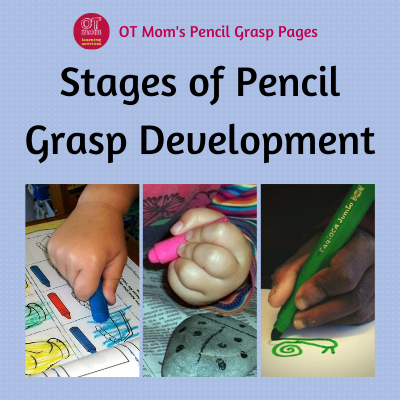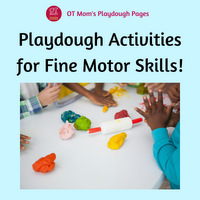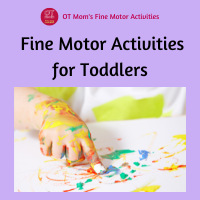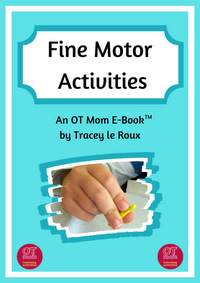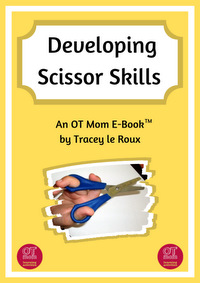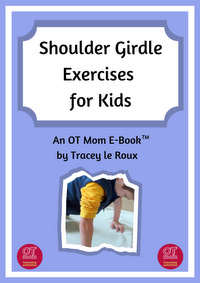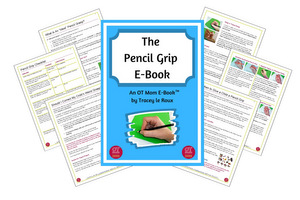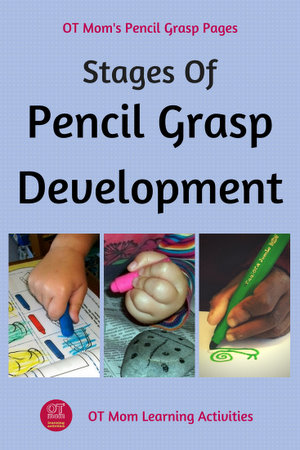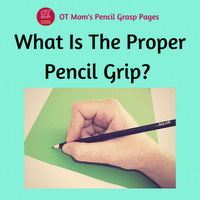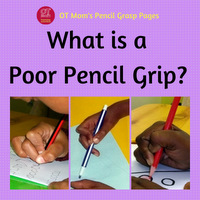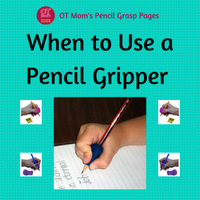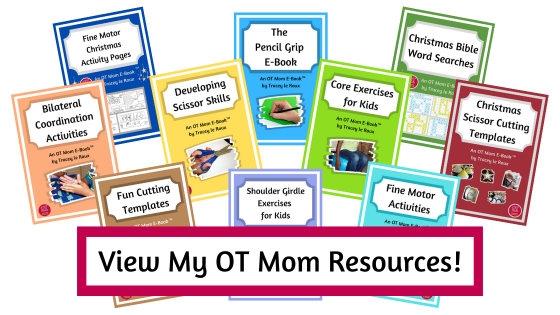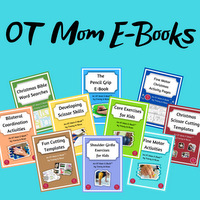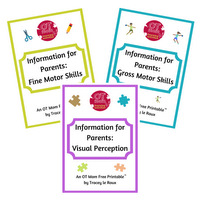- Home Page
- All About Pencil Grasp
- Pencil Grasp Development
Pencil Grasp Development
As an occupational therapist, one of the most common concerns that parents raise is about pencil grasp development.
You see your little one holding a crayon in a tight fist and wonder "Should I fix that? Are they behind?"
So let's put your mind at ease! Moving through the different stages of holding a pencil is an important part of childhood development. And it is a journey, not a race!
On this page I will walk you through the natural pencil grip stages so you can feel confident in supporting your child!
* Haz click aquí para español: Agarre Del Lápiz
For your convenience, I may link to products that are similar to the ones I use. I may receive a small commission if you purchase a product through my links, at no additional cost to you. Thank you for supporting my site!
Principles of Pencil Grasp Development
There are general principles of a child's motor development called “big to small” and “proximal
to distal” (Myers)
Basically this means that children develop control over the larger muscles of the trunk and arms which are closer to the body centre (proximal) before the smaller muscles of the hands which are distal (further away from the body centre).
Learning to control a pencil or crayon with the hands and fingers is therefore somewhat dependent on how “strong and steady” the shoulder and arm muscles are.
As your child develops physically, and takes part in lots of fun gross motor activities such as creeping / crawling, climbing and pushing, the shoulder and arm muscles will get stronger and steadier, and this can have a positive effect on the development of fine motor skills, including pencil grasp.
Stages of Pencil Grip
(As
it is really hard to take good photos of kiddie hands in action, most
of the stages below are demonstrated by adult hands holding the pencil.)
1) Fisted Grasp
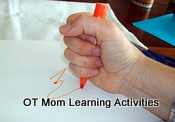 Fisted Grasp
Fisted GraspWhen your toddler first grabs a thick crayon and puts it to paper (hopefully not to your walls!), this is the grasp you could be seeing.
It is a “fisted grasp”, and your toddler will be using movement from the shoulder to get the crayon to move across the paper.
It is also known as a palmar supinate grasp, as the crayon lies across the palm of the hand.
2) Digital Pronate Palmar Grasp
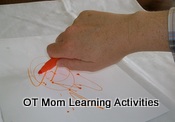 Palmar Grasp
Palmar GraspAs your toddler gains more control over arm and hand muscles, you will see this digital pronate “palmar" grasp being used.
Here, the pencil lies across the palm of the hand and your child’s elbow is held out to the side a bit.
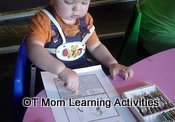 Palmar Grasp (toddler)
Palmar Grasp (toddler)The shoulder muscles are steadier, and your child is using the arm muscles to move the crayon around, as well as the shoulder muscles.
This photo shows a toddler beginning to engage the fingers (the digits) but the crayon is still across the palm of the hand.
If the crayon is no longer sticking out from the side of the fingers, and the fingers are on the pencil and pointing down to the paper, then it is officially a digital pronate grasp.
3) Five Finger Pencil Grasp
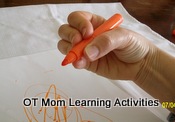 5-Finger Pencil Grasp
5-Finger Pencil GraspThis is sometimes, misleadingly, called an “immature” 5-finger pencil grasp – it is immature because it is not the 3-finger grasp that is used in school, but it is a perfectly mature grasp for a 4-year old!
As you can see, there are 5 fingers holding the pencil.
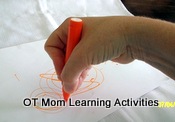
With this 5-finger pencil grasp, the wrist is usually held off the table and wrist movements are used for coloring.
The crayon is often held very tightly initially, but as the hand muscles develop, you should see a few finger movements emerging.
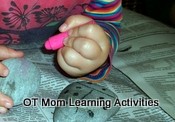 5 Finger Pencil Grasp (toddler)
5 Finger Pencil Grasp (toddler)This left-handed toddler has developed a 5 point pencil grasp that is appropriate for her age.
Sometimes kids use 4 fingers instead of 5, but regardless, this grip is static - movement is primarily coming from the wrist and hand, and not from the fingers.
4) Tripod Pencil Grasp
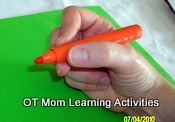 Tripod Pencil Grip
Tripod Pencil GripBy age 5-6, or even a bit later with some children, they should be comfortable using a tripod pencil grip, where the thumb, middle and index fingers are grasping the pencil or crayon.
At first, the fingers will be held stiffly (a "static tripod" grip) and your child may still use wrist movements to draw and color.
As the finger muscles become more skilled, your child will be able to use finger movements to draw and to form letters - this is a "dynamic tripod" grip.
How To Support Healthy Pencil Grip Development
Instead of correcting your child's grip, rather focus on providing a range of play-based activities that strengthen hands and fingers and get them ready to hold a pencil!
Playdough is your best friend!
Squeezing, rolling, pinching and squishing playdough will give your child's hands a real workout!
A parent from India once shared with me that in her village, mothers give their children real bread dough to play with for this very reason!
Need playdough activity ideas? Check out these free activities on my site!
Get Snipping With Scissors!
Cutting with scissors helps develop hand strength and teaches a child to use both hands together cooperatively.
Even toddlers can start snipping with safety scissors - check out my page about getting your child started with scissor skills!
Get Hands-On
In this digital age, it is more important than ever to help your child get lots of hands-on activities to balance out screen time on devices.
From threading large beads, building with blocks, help your child get engaged with hands on activities to optimize fine motor development!
Don't forget the big muscles!
Give your child lots of opportunities to climb, crawl, pull and push - upper body strength and core strength are so important for fine motor development!
Try the fun and easy exercises in my shoulder girdle and core exercises resources!
Questions Parents Ask
Click on the questions to read the answers to common questions parents ask about their child's pencil grasp development
Should I correct my toddler's pencil grip?
Should I correct my toddler's pencil grip?
This is a question that parents often ask. The simple answer is that it is not developmentally appropriate to force a toddler to write with the same grasp as a six-year-old.
Think of it this way: you wouldn't expect your two-year-old to walk, run, and skip with the coordination of a six-year-old. We expect them to be wobbly and clumsy because we know they are building strength and balance. The same principle applies to their hands.
A toddler holds a crayon with their whole hand because their larger arm and shoulder muscles are doing the work.
Their small, intricate hand muscles are still developing, and are not yet ready to hold the pencil in a mature way.
Forcing your toddler to hold a pencil "correctly" before these muscles are ready is like asking them to run before they can walk.
It often leads to frustration and can even result in awkward, inefficient grips later on as they try to compensate for a lack of strength and control.
Rather encourage your toddler to take part in lots of hands-on activities to develop the fine motor skills needed.
My child keeps going back to an immature grasp
My child keeps going back to an immature grasp
Don’t be surprised if you see your young child switching between pencil grasps.
As the shoulder and arm muscles become stronger and steadier, your child should switch less and less.
We can liken this to a baby learning to walk – when his legs are tired of walking, he goes back to crawling, but as his endurance and skill improves, he will walk more and more!
So
don’t discourage your child from going back to an earlier grasp;
instead, promote correct pencil grasp development and endurance by working on the the underlying foundations for good fine motor development.
Is there more than one good way to hold a pencil?
Is there more than one good way to hold a pencil?
Although the tripod pencil grip has traditionally been considered to be the best way to hold a pencil because it allows for the most finger movements, there are other ways of holding the pencil that also allow for some good finger movements.
Please read my page on different, functional ways to hold a pencil to view photos and descriptions of other pencil grasps that may work for your child, including the D'Nealian Pencil Grasp.
The D'Nealian pencil grasp (also known as the Monks grasp) is when the pencil is held between the index and middle fingers, and can be very helpful for kids (and adults!) who struggle with weak hands, low muscle tone, and/or joint pain.
Pencil Grip Information Resource
Do you have questions about your child's pencil grip, or about what constitutes a poor pencil grip?
This printable resource aims to help by answering common questions that teachers and parents have about how a child should hold a pencil.
Many people think that the dynamic tripod grip is the only functional way to hold the pencil, but in reality, there are some variations on the tripod grip that can also be functional – I show these, as well as photos of dysfunctional grips and feedback on each.
Thank you for visiting this page on pencil grasp development! I hope you found it helpful!
You can receive updates on new pages and activity ideas by signing up for my occasional newsletter.
Please consult your local health professional if you are in any way concerned about your child's pencil grasp development.
- Home Page
- All About Pencil Grasp
- Pencil Grasp Development
Share this page to help others!
Related Pencil Grip Pages
References
- Benbow, M. Neurokinesthetic approach to hand function and handwriting. Albuquerque: Clinician’s View, 1995
- Myers, Beverly. Proprioceptive Neuromuscular Facilitation (PNF) Approach. Occupational Therapy for Physical Dysfunction. Baltimore: Williams & Wilkins, 1995.
- Selin, A-S. Pencil grip: a descriptive model and 4 empirical studies (dissertation). Abo Akademi University Press, 2003. ISBN 951-765-130-9
Didn't find what you were looking for? Try a search of my site!
